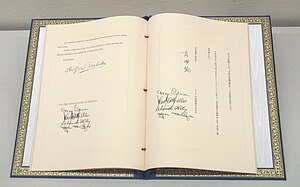
Back پیمان امنیتی بین ایالات متحده و ژاپن Persian Traité de sécurité entre les États-Unis et le Japon French 日本国とアメリカ合衆国との間の安全保障条約 Japanese 미일안전보장조약 Korean Tratado de Segurança entre Estados Unidos e Japão Portuguese Японо-американский договор безопасности Russian Yaponiya-AQSh xavfsizlik shartnomasi Uzbek
| Security Treaty between the United States and Japan | |
|---|---|
 | |
| Type | Military alliance |
| Signed | 8 September 1951 |
| Location | San Francisco, United States |
| Effective | 28 April 1952 |
| Expiration | June 23, 1960 (revised and replaced) |
| Parties | |
The Security Treaty between the United States and Japan (日本国とアメリカ合衆国との間の安全保障条約, Nippon-koku to Amerika Gasshūkoku to no aida no anzen hoshō jōyaku) was a treaty signed on 8 September 1951 in San Francisco, California by representatives of the United States and Japan, in conjunction with the Treaty of San Francisco that ended World War II in Asia. The treaty was imposed on Japan by the United States as a condition for ending the Occupation of Japan and restoring Japan's sovereignty as a nation.[1] It had the effect of establishing a long-lasting military alliance between the United States and Japan.
The agreement contained five articles, which dictated that Japan allow the United States to continue maintaining military bases on Japanese soil even after the end of the Occupation. The accord prohibited Japan from providing foreign powers any bases or military-related rights without the consent of the United States. Moreover, the accord allowed the United States to use military forces stationed in Japan without prior consultation with the Japanese government and did not mention any requirement for U.S. forces to defend Japan if Japan were to be attacked.[1] Troublingly for many Japanese, the treaty had no set expiration date, nor did it specify any precise mechanism of abrogation.
The accord was ratified by the U.S. Senate on 20 March 1952 and was signed into U.S. law by U.S. President Harry Truman on 15 April 1952. The treaty went into effect on 28 April 1952, in conjunction with the effectuation of the Treaty of San Francisco that ended the Occupation.[1] At the time, the United States maintained 260,000 troops on Japanese soil, making use of 2,824 facilities throughout the nation (not counting additional soldiers and bases in Okinawa, which remained under direct American control at the time).[2]
In addition to the treaty itself, an "Administrative Agreement" of 29 articles spelling out exact details of the basing agreement was negotiated in secret between the Japanese and United States governments and made public without a vote by either government's legislature on February 28, 1952.[3]
The treaty was highly controversial among the Japanese public, which led to widespread protests throughout the country. As a result, negotiations between leaders Nobusuke Kishi and Dwight D. Eisenhower followed, and the treaty was eventually superseded and replaced by the revised Treaty of Mutual Cooperation and Security between the United States and Japan on June 19, 1960.
- ^ a b c Kapur 2018, p. 11.
- ^ Kapur 2018, p. 14.
- ^ Packard 1966, pp. 6–7.
© MMXXIII Rich X Search. We shall prevail. All rights reserved. Rich X Search